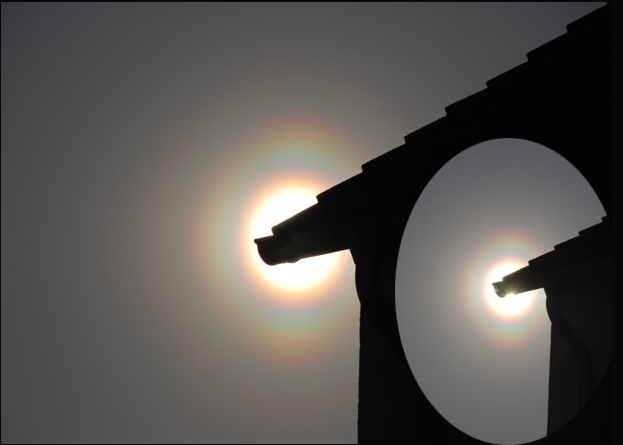Pollen, telescopes and coal dust
Pollen, Telescopes, and Coal Dust: Unveiling the Secrets of Atmospheric Optics
Have you ever marveled at the beautiful rings and aureoles that surround the moon or the sun? These captivating phenomena, known as coronae, are not solely created by water droplets. Surprisingly, they can also be formed by particles such as pollen, coal, and even telescopes. In this article, we will delve into the fascinating world of atmospheric optics and explore how these seemingly unrelated elements contribute to the creation of stunning coronae.
The Science Behind Coronae Formation
Coronae are formed through a process called diffraction, where light waves scatter from the outer surfaces of tiny particles and combine to create intricate patterns. Unlike rainbows, which require water droplets to form, coronae can be produced by a variety of substances, including pollen, coal dust, and even telescopes. This phenomenon highlights the versatility and complexity of atmospheric optics.
The Role of Pollen in Coronal Displays
During springtime, trees release billions of pollen grains into the air. These minuscule particles are not only responsible for triggering allergies but also for producing spectacular coronae. Pollen grains from a single tree species are typically uniform in size, resulting in sharp and multi-ringed coronae. Additionally, these grains possess air sacs that aid in their dispersion. As a result, when light interacts with these pollen grains, anisotropic scattering occurs, leading to the formation of oval-shaped rings with areas of intense brightness.
Telescopes: More than Meets the Eye
While telescopes are primarily associated with celestial observations, they also play a surprising role in atmospheric optics. Babinet's Principle, a fundamental concept in diffraction theory, states that an aperture with the same shape as an obstruction will produce the same diffraction pattern. When we examine tiny stars under high magnification through a telescope, we observe what are known as Airy disks. These disks are essentially coronae produced by the circular aperture of the telescope itself. Thus, telescopes not only allow us to explore the vastness of the universe but also offer valuable insights into the intricate patterns of atmospheric optics.
Unveiling the Beauty of Coal Dust Coronae
In addition to pollen and telescopes, coal dust particles also have the potential to create mesmerizing coronae. Just like pollen grains, coal dust particles scatter light waves through diffraction, resulting in the formation of intricate patterns. While coal dust coronae may not be as commonly observed as those formed by pollen, they offer a unique opportunity to witness the beauty of atmospheric optics in an unexpected context.
Further Exploration and Research Opportunities
The study of atmospheric optics is a continuously evolving field, offering ample opportunities for further exploration and research. By expanding our understanding of the intricate processes that give rise to coronae, we can gain insights into the behavior of light and the properties of different particles. Moreover, these findings can have practical applications in various fields, including meteorology, astronomy, and environmental science.
Conclusion
In conclusion, the enchanting coronae that grace our skies are not solely a result of water droplets. Pollen grains, coal dust particles, and even telescopes contribute to the creation of these captivating atmospheric phenomena. By understanding the science behind coronae formation and exploring the diverse range of particles that can generate these optical wonders, we can deepen our appreciation for the beauty and complexity of our natural world. So, next time you gaze at the sky and witness a corona encircling the sun or the moon, remember the hidden role played by pollen, telescopes, and coal dust in bringing this ethereal spectacle to life.

A corona from pollen dust imaged by Eva Seidenfaden ~ "Paraselene" atmospheric optics site ~ at Trier, Germany May 12th '08.
©Eva Seidenfaden, shown with permission.
Water drops are not essential to make a corona, the bright aureole and rings we see around the moon or (when its bright disk is well shielded) the sun. Pollen, coal or telescopes will do equally.
Light waves scattered from the outsides of small particles combine in a diffraction pattern to make a corona. Therefore the particles can be opaque.
Pollen grains shed in billions by spring trees produce excellent coronae. Grains from a single tree variety are same-sized and hence their coronae are sharp and multi-ringed. The grains have air sacs to help disperse them and these orient each grain. The result is anisotropic scattering and oval rings with bright areas.
Telescopes? Babinet's Principle predicts that an aperture of the same shape as an obstruction produces the same diffraction pattern. The tiny star Airy disks seen under high magnification are in-effect corona produced by the circular telescope aperture.
Note: this article has been automatically converted from the old site and may not appear as intended. You can find the original article here.
Reference Atmospheric Optics
If you use any of the definitions, information, or data presented on Atmospheric Optics, please copy the link or reference below to properly credit us as the reference source. Thank you!
-
<a href="https://atoptics.co.uk/blog/pollen-telescopes-and-coal-dust/">Pollen, telescopes and coal dust</a>
-
"Pollen, telescopes and coal dust". Atmospheric Optics. Accessed on November 26, 2024. https://atoptics.co.uk/blog/pollen-telescopes-and-coal-dust/.
-
"Pollen, telescopes and coal dust". Atmospheric Optics, https://atoptics.co.uk/blog/pollen-telescopes-and-coal-dust/. Accessed 26 November, 2024
-
Pollen, telescopes and coal dust. Atmospheric Optics. Retrieved from https://atoptics.co.uk/blog/pollen-telescopes-and-coal-dust/.